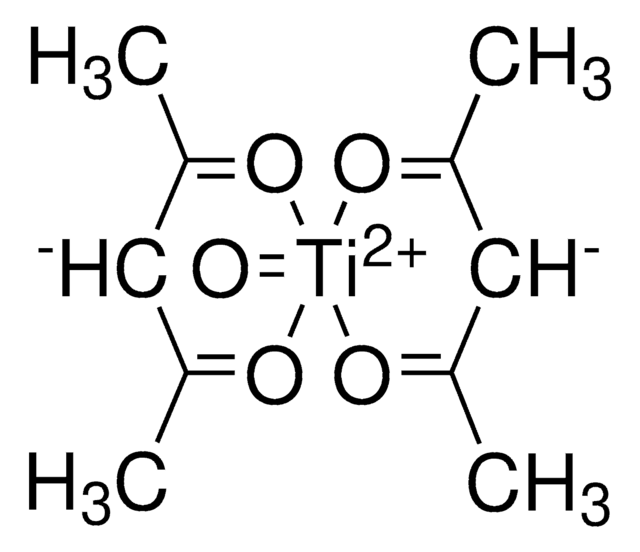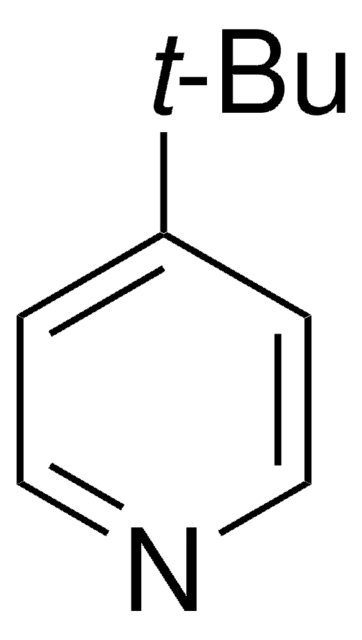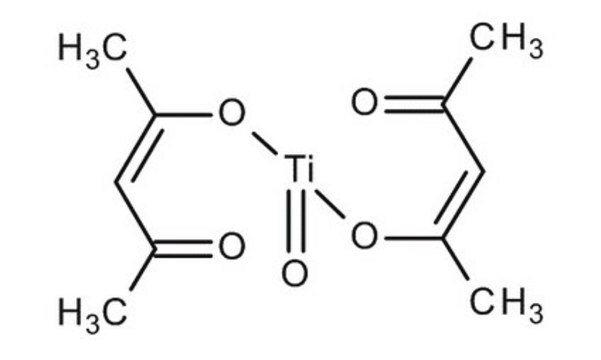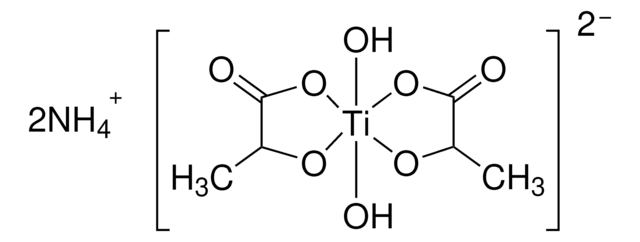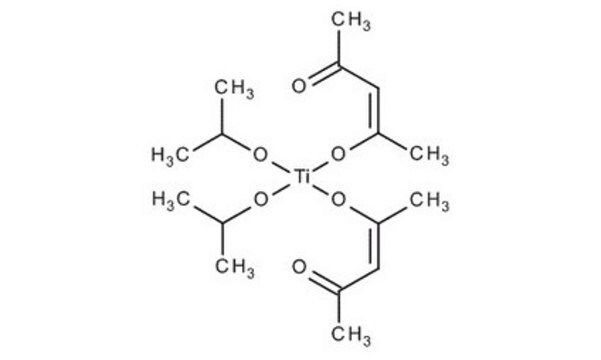325252
Titanium diisopropoxide bis(acetylacetonate)
75 wt. % in isopropanol
Sinônimo(s):
Diisopropoxytitanium bis(acetylacetonate) solution, TYZOR® AA organic titanate, Ti(acac)2OiPr2
About This Item
Produtos recomendados
Formulário
solution
Nível de qualidade
composição
Ti, 9-10.5% gravimetric
adequação da reação
core: titanium
reagent type: catalyst
concentração
75 wt. % in isopropanol
índice de refração
n20/D 1.4935
densidade
0.995 g/mL at 25 °C
cadeia de caracteres SMILES
CC(C)O[Ti](OC(C)C)(O\C(C)=C\C(C)=O)O\C(C)=C\C(C)=O
InChI
1S/2C5H8O2.2C3H7O.Ti/c2*1-4(6)3-5(2)7;2*1-3(2)4;/h2*3,6H,1-2H3;2*3H,1-2H3;/q;;2*-1;+4/p-2/b2*4-3+;;;
chave InChI
OVSGBKZKXUMMHS-VVDZMTNVSA-L
Procurando produtos similares? Visita Guia de comparação de produtos
Categorias relacionadas
Aplicação
Informações legais
Palavra indicadora
Danger
Frases de perigo
Declarações de precaução
Classificações de perigo
Eye Dam. 1 - Flam. Liq. 2 - STOT SE 3
Órgãos-alvo
Central nervous system
Código de classe de armazenamento
3 - Flammable liquids
Classe de risco de água (WGK)
WGK 3
Ponto de fulgor (°F)
53.6 °F - closed cup
Ponto de fulgor (°C)
12 °C - closed cup
Equipamento de proteção individual
Eyeshields, Faceshields, Gloves, type ABEK (EN14387) respirator filter
Escolha uma das versões mais recentes:
Já possui este produto?
Encontre a documentação dos produtos que você adquiriu recentemente na biblioteca de documentos.
Os clientes também visualizaram
Artigos
New methods for materials fabrication at the micro- and nanoscale will drive scientific and technological advances in areas of materials science, chemistry, physics, and biology. The broad diversity of potentially relevant materials, length scales, and architectures underscores the need for flexible patterning approaches. One important example is the fabrication of 3D periodic structures composed of colloidal, polymeric, or semiconductor5 materials.
Few Monolayer Atomic Layer Deposition (ALD) on Surfaces and Interfaces for Energy Applications
Titanium dioxide (TiO2) is an important n-type semiconducting material that shows interesting characteristics such as photoswitchable surface wettability, high photocatalytic activity, bistable electrical resistance states and high electron drift mobility.
The properties of many devices are limited by the intrinsic properties of the materials that compose them.
Global Trade Item Number
| SKU | GTIN |
|---|---|
| 325252-500ML | 4061838253231 |
| 325252-5ML | |
| 325252-100G | |
| 325252-100ML | 4061826712801 |
| 325252-500G |
Nossa equipe de cientistas tem experiência em todas as áreas de pesquisa, incluindo Life Sciences, ciência de materiais, síntese química, cromatografia, química analítica e muitas outras.
Entre em contato com a assistência técnica

